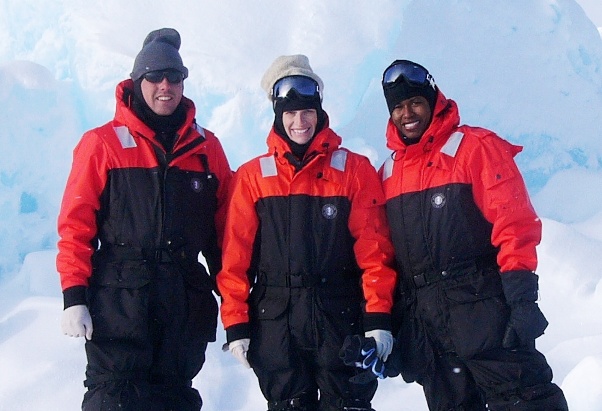Skidaway Institute research tech Victoria Baylor and grad student Zac Tait just returned to warm, sunny Skidaway Island from their first sample trip to Barrow, Alaska. Here is their account of their interesting trip.
Our trip was part of our Professor, Dr. Marc Frischer’s, three-year project to study the effects of climate change (ie: global warming) on microscopic organisms in the Arctic Ocean. You can read more about this project HERE.
We left Savannah on April 20th to join collaborators from the Virginia Institute for Marine Science and the University of Georgia at the Barrow Arctic Science Consortium campus where we did our lab and field work out on the sea ice of the Arctic Ocean.
We made it out on the ice three separate times to conduct our research. The temperature ranged between zero and 25 degrees Fahrenheit, just a little cooler than what we are used to in Coastal Georgia. During this time of spring in Barrow Alaska, there were 18 hours of sunlight each day.
Luckily, we had so much to do each day none of us had trouble falling asleep with the sun still up. In order to travel out onto the ice, we needed a field guide to provide us direction and protect us from polar bears. Yes, polar bears! That’s sort of ironic when you see all those pictures floating around on the internet of polar bears on melting ice floes.
To get to our sample site, we drove snow machines across the frozen Arctic Sea on ice trails cut through ice pressure ridges that in some spots were over 30 feet tall.  When we found a site to drill a hole through the ice to collect sea water, the ice was 22 inches thick. We ran a hose underneath the ice to a depth of eight meters and then pumped the water through a series of filters to collect bacteria and other microorganisms.
When we found a site to drill a hole through the ice to collect sea water, the ice was 22 inches thick. We ran a hose underneath the ice to a depth of eight meters and then pumped the water through a series of filters to collect bacteria and other microorganisms.
The samples went into liquid nitrogen and then were shipped back to Skidaway for processing.
Barrow isn’t that small of a town considering it’s geography. There are around 4,000 to 5,000 residents that live there year round. At the end of the day, we typically went out to eat. There are many restaurants to choose from including a Chinese restaurant and a Mexican Restaurant. The array of food to eat was surprising but not as surprising as the prices. One Chinese restaurant had a 12 piece bucket of fried chicken for $46! We also visited the local grocery a few times where a gallon of milk costs $11 dollars. We were told the prices were so expensive because all of the food had to be flown up there.
On April 28th, we boarded a plane and flew back to Georgia with only 1 to 2 hour layovers at each stop. It was a long trip and roughly 17 hours of flying! Barrow Alaska is unlike anything either of us had ever experienced before. After arriving in Georgia, and being hit by the sweltering humidity, we all missed the cold weather of Barrow a little bit.
We have several more trips planned for the future. The next will probably be near the end of August or the beginning of September when the sea ice has melted in Barrow.




